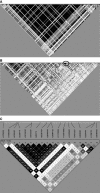Mapping the 17q12-21.1 Locus for Variants Associated with Early-Onset Asthma in African Americans
- PMID: 32966749
- PMCID: PMC7885840
- DOI: 10.1164/rccm.202006-2623OC
Mapping the 17q12-21.1 Locus for Variants Associated with Early-Onset Asthma in African Americans
Abstract
Rationale: The 17q12-21.1 locus is one of the most highly replicated genetic associations with asthma. Individuals of African descent have lower linkage disequilibrium in this region, which could facilitate identifying causal variants.Objectives: To identify functional variants at 17q12-21.1 associated with early-onset asthma among African American individuals.Methods: We evaluated African American participants from SAPPHIRE (Study of Asthma Phenotypes and Pharmacogenomic Interactions by Race-Ethnicity) (n = 1,940), SAGE II (Study of African Americans, Asthma, Genes and Environment) (n = 885), and GCPD-A (Study of the Genetic Causes of Complex Pediatric Disorders-Asthma) (n = 2,805). Associations with asthma onset at ages under 5 years were meta-analyzed across cohorts. The lead signal was reevaluated considering haplotypes informed by genetic ancestry (i.e., African vs. European). Both an expression-quantitative trait locus analysis and a phenome-wide association study were performed on the lead variant.Measurements and Main Results: The meta-analyzed results from SAPPHIRE, SAGE II, and the GCPD-A identified rs11078928 as the top association for early-onset asthma. A haplotype analysis suggested that the asthma association partitioned most closely with the rs11078928 genotype. Genetic ancestry did not appear to influence the effect of this variant. In the expression-quantitative trait locus analysis, rs11078928 was related to alternative splicing of GSDMB (gasdermin-B) transcripts. The phenome-wide association study of rs11078928 suggested that this variant was predominantly associated with asthma and asthma-associated symptoms.Conclusions: A splice-acceptor polymorphism appears to be a causal variant for asthma at the 17q12-21.1 locus. This variant appears to have the same magnitude of effect in individuals of African and European descent.
Keywords: African Americans; GSDMB; ORMDL3; asthma; chromosome 17.
Figures




Comment in
-
Diversity and the Splice of Life: Mapping the 17q12-21.1 Locus for Variants Associated with Early-Onset Asthma in African American Individuals.Am J Respir Crit Care Med. 2021 Feb 15;203(4):401-403. doi: 10.1164/rccm.202010-3802ED. Am J Respir Crit Care Med. 2021. PMID: 33108222 Free PMC article. No abstract available.
References
-
- Vos T, Flaxman AD, Naghavi M, Lozano R, Michaud C, Ezzati M, et al. Years lived with disability (YLDs) for 1160 sequelae of 289 diseases and injuries 1990-2010: a systematic analysis for the Global Burden of Disease Study 2010 Lancet 20123802163–2196.[Published erratum appears in Lancet 381:628.] - PMC - PubMed
-
- Asher MI, Montefort S, Björkstén B, Lai CK, Strachan DP, Weiland SK, et al. ISAAC Phase Three Study Group. Worldwide time trends in the prevalence of symptoms of asthma, allergic rhinoconjunctivitis, and eczema in childhood: ISAAC phases one and three repeat multicountry cross-sectional surveys. Lancet. 2006;368:733–743. - PubMed
-
- Papi A, Brightling C, Pedersen SE, Reddel HK. Asthma. Lancet. 2018;391:783–800. - PubMed
-
- Broder I, Higgins MW, Mathews KP, Keller JB. Epidemiology of asthma and allergic rhinitis in a total community, Tecumseh, Michigan: IV. Natural history. J Allergy Clin Immunol. 1974;54:100–110. - PubMed
-
- Dodge RR, Burrows B. The prevalence and incidence of asthma and asthma-like symptoms in a general population sample. Am Rev Respir Dis. 1980;122:567–575. - PubMed
Publication types
MeSH terms
Grants and funding
- R01 HL120393/HL/NHLBI NIH HHS/United States
- HHSN268201600032C/ES/NIEHS NIH HHS/United States
- R35 HL145235/HL/NHLBI NIH HHS/United States
- R01 AI079139/AI/NIAID NIH HHS/United States
- R01 HL141845/HL/NHLBI NIH HHS/United States
- R01 HL135156/HL/NHLBI NIH HHS/United States
- HHSN268201800001C/HL/NHLBI NIH HHS/United States
- U19 AI077439/AI/NIAID NIH HHS/United States
- R21 ES024844/ES/NIEHS NIH HHS/United States
- R01 HL117626/HL/NHLBI NIH HHS/United States
- R01 HL118267/HL/NHLBI NIH HHS/United States
- R01 MD010443/MD/NIMHD NIH HHS/United States
- R01 ES015794/ES/NIEHS NIH HHS/United States
- R01 AI061774/AI/NIAID NIH HHS/United States
- R01 DK113003/DK/NIDDK NIH HHS/United States
- P30 ES006694/ES/NIEHS NIH HHS/United States
- R01 HL128439/HL/NHLBI NIH HHS/United States
- R01 HL079055/HL/NHLBI NIH HHS/United States
- R01 HL117004/HL/NHLBI NIH HHS/United States
- P60 MD006902/MD/NIMHD NIH HHS/United States
- R01 DK064695/DK/NIDDK NIH HHS/United States
LinkOut - more resources
Full Text Sources
Other Literature Sources

